|
Two months after the worst natural disaster in recent history, hundreds of thousands of people are still struggling to rebuild lives shattered by the tsunami.
On March 5, rugby teams representing the northern and southern hemispheres will stage a match - Rugby Aid: Rebuilding after the Tsunami - at Twickenham to help raise funds for WFP efforts to kick-start this critical rehabilitation process.
Click on our guide to learn how WFP projects are helping to get the region back on its feet.
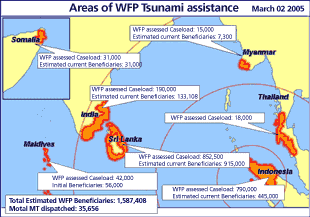
The aftermath
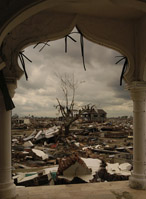 It is difficult to overstate the sheer scale of the catastrophe that hit regions such as Aceh in Indonesia. It is difficult to overstate the sheer scale of the catastrophe that hit regions such as Aceh in Indonesia.
This was not a disaster that simply shook buildings to the ground and rendered people homeless.
This was a calamitous event that tore away the very fabric of the landscape. In parts of Aceh, whole sections of the coastline were literally swallowed up.
Salt-water lakes have filled areas inland that were once rice paddy fields growing food for local populations. Fresh-water wells, a vital resource for rural villagers, have been flooded with salt water and raw sewerage.
The needs are immense. For example, an assessment survey by agencies including WFP found that more than 970 schools in Indonesia were destroyed by the earthquake and the tsunami, leaving almost 180,000 school children without the means to continue their education.
Rebuilding their lives and giving them hope for the future will not happen over night.
Back to top 

WFP tsunami response
In response to the 26 December tsunami which left more than 300,000 dead or missing and more than one million homeless, WFP launched one of its largest humanitarian operations in history, immediately moving food, equipment and personnel to the disaster zone.
Less than two months later, WFP is now feeding more than 1.5 million people in Sri Lanka, Indonesia, the Maldives, Myanmar, Thailand and Somalia.
In order to distribute life-saving food aid across the region, WFP has set up 11 new offices and logistics bases in the countries affected, as well as a UN base camp in Banda Aceh which accommodates 90 people.
WFP’s tsunami response covers three broad phases:
- Phase I – Acute Emergency [January-February]. WFP and its partners respond with relief distributions.
- Phase II – Transition to Rehabilitation and Recovery [March-June]. As the situation stabilises, relief distributions will be reduced in favour of expanded supplementary feeding and rehabilitation activities, supporting the rebuilding of livelihoods, assets and infrastructure.
- Phase III – Recovery [July onwards]. Activities may include longer-term Food for Work projects with higher technical input.
Back to top 

WFP logistics
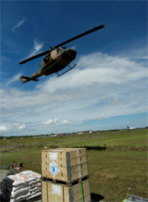
This disaster presented WFP with one of its most logistically challenging operations yet; working in places where much of the infrastructure was damaged or destroyed, where existing capacities were already limited, and where many areas are remote and cut off from normal supply lines.
To overcome these challenges, WFP has set up an enormous logistics operation using every available means to get food to the people who need it across the region.
WFP Indonesia is now using:
- 4 sea vessels under WFP control, including two cargo vessels (with capacities of 3,000 and 4,500 metric tons respectively, also being used as floating warehouses) and two 400-ton landing craft delivering supplies to hard-to-reach areas along the west coast of Sumatra;
- 152 trucks;
- 2 fixed-wing aircraft and a Twin Otter passenger plane for the movement of personnel;
- 5 helicopters;
- 12 permanent and temporary warehouses with a total capacity of 6,550 metric tons; 20 metric tons of storage space at government warehouses;
- 60 additional light vehicles.
WFP Sri Lanka is now using:
- WFP has mobilised 13 trucks from the agency's Asia Regional Reserve Facility in Cambodia and has been given the use of 70 trucks from private sector companies, notably TNT;
- Unilever Sri Lanka has supplied a cargo train running from the capital Colombo to Vavunya in the north and to Batticaloa and Trincomalee in the east.
Back to top 

Rebuilding after the Tsunami
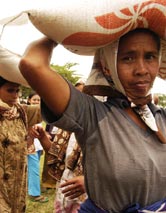 WFP has three decades' experience of using food as an incentive to encourage reconstruction in the aftermath of a natural disaster.
WFP has three decades' experience of using food as an incentive to encourage reconstruction in the aftermath of a natural disaster.
Assessments are already underway across the region looking at food security issues. These will provide a framework for WFP to plan recovery projects with the Indonesian and Sri Lankan governments.
In the recovery stage, WFP will target its food distributions at the weakest such as the elderly, widows, orphans, disabled people, mothers and their infants.
At the same time Food for Work projects, in which communities receive food in exchange for their labour, will help to kick-start the rebuilding of vital infrastructure including roads, bridges, schools and community buildings.
School feeding programmes provide an incentive for parents to send their children back to school. In classes, the children receive a balanced and nutritious meal that aids their physical development, helps them to concentrate on their lessons, and relieves the burden on their families to provide more food.
Back to top 

Indonesia - moving to recovery
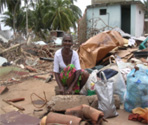 Along Sumatra's north and western coasts, people are still trying to come to grips with almost complete devastation. In many areas survivors have fled the coast entirely to set up camp five to ten km inland; of the 2.8 million people hit by the disaster, up to 790,000 people are in need of food assistance.
Along Sumatra's north and western coasts, people are still trying to come to grips with almost complete devastation. In many areas survivors have fled the coast entirely to set up camp five to ten km inland; of the 2.8 million people hit by the disaster, up to 790,000 people are in need of food assistance.
WFP's beneficiaries include displaced persons living in mosques, schools and hospitals. The agency is also targeting people living with host families, fishermen and shopkeepers who lost their means of earning money, and people living in isolated communities.
As of 25 February, WFP had fed 455,000 beneficiaries and dispatched over 10,500 metric tons of commodities.
WFP is collaborating with the Government of Indonesia, the Indonesian Red Cross (PMI), Save the Children/USA, Action Contre la Faim (ACF), CARE Australia, Mercy Corps International, Help Germany, World Vision International and Catholic Relief Services (CRS).
Back to top 

Sri Lanka - starting vulnerable group feeding a and school feeding programmes
WFP has reached more than 850,000 beneficiaries in Sri Lanka through general food distributions during the first two months of the operation. More than 16,000 metric tons of food has been dispatched over this period.
The agency succeeded in reaching its initial target number of 750,000
people within three weeks of the disaster.
In collaboration with the government of Sri Lanka and cooperating partner World Vision, WFP is now finalising plans to start school feeding and vulnerable group feeding programmes.
In March, the agency plans to reach 649,000 through vulnerable group feeding programmes in tsunami-affected areas in Sri Lanka.
Back to top 

Maldives - supplementary feeding underway
In the weeks following the tsunami, WFP provided more than 46,000 beneficiaries in the Maldives with fortified biscuits.
More recently, the agency has been providing 24,000 school children with biscuits in a school feeding programme.
WFP is now helping the government to expand its vulnerable group feeding programme to reach an estimated 42,000 vulnerable people for a two-month period.
Back to top 

India, Myanmar, Somalia and Thailand
In India, WFP is continuing distributions of fortified biscuits as a supplementary food ration to 130,000 beneficiaries in Tamil Nadu province.
WFP Myanmar is providing general food relief rations to 7,300 beneficiaries. Through continued relief support and the introduction of limited food-for-work activities, approximately 15,000 people will be reached.
In Thailand, WFP is supporting people living in the six southern provinces hit by the tsunami through a school feeding programme (targeting 8,000 students) as well as support to 2,000 vulnerable families.
WFP Somalia has completed the first round of distributions to 30,500 beneficiaries and a second round of food distributions is now underway. Following a recent assessment, WFP is looking at possible reconstruction activities in conjunction with partners to help to promote livelihood restoration in affected areas along the coast.
Back to top 

|
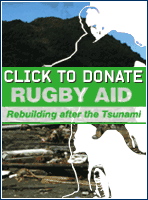
Read about WFP's response to the
tsunami crisis |
|
 |
|
|
 |
|
|
 |
|
|
 |
|
|
|
 |
 |
The International Rugby Board (IRB) will donate proceeds from the match Rugby Aid: Rebuilding after the tsunami to its humanitarian partner WFP
|
 |
The match will pitch a Northern Hemisphere XV, captained by Ireland centre Brian O'Driscoll and coached by World Cup winner Clive Woodward, against a Southern Hemisphere XV captained by George Gregan and coached by Rod Macqueen, both of Australia |
 |
Northern Hemisphere squad: C Paterson (Scotland), A Rougerie (France), B Cohen (England), B O'Driscoll (Ireland, capt), D Traille (France), O Smith (England), C Sweeney (Wales), D Humphreys (Ireland), C Cusiter (Scotland), D Peel (Wales), A Lo Cicero (Italy), P de Villiers (France), J Yapp (Wales), G Bulloch (Scotland), R Ibanez (France), P O'Connell (Ireland), M Bortolami (Italy), J Thomas (Wales), S Taylor (Scotland), L Dallaglio (England), S Parisse (Italy) |
 |
Southern Hemisphere squad: C Latham (Australia), R Caucaunibuca (Fiji), J Fourie (SA), T Umaga (New Zealand), S Bobo (Fiji), A Mehrtens (NZ), G Gregan (Aus, capt), C Hoeft (NZ), J Smit (SA), C Visagie (SA), V Matfield (SA), I Rawaqa (Fiji), S Burger (SA), P Waugh (Aus), T Kefu (Aus). Replacements: B Reihana (NZ), B Lima (Samoa), E Taukafa (Tonga), O Palepoi (Samoa), S Sititi (Samoa), M Rauluni (Fiji) |
 |
The IRB and WFP first teamed up for the Rugby World Cup in Australia in 2003, where Tackle Hunger helped raise awareness of the world's 800 million hungry people |
 |
The winning captains of the first four editions of the World Cup all encouraged the event's global audience to Tackle Hunger, while Australia's Nick Farr-Jones and New Zealand's David Kirk became official ambassadors for the campaign |
 |
Nick Farr-Jones, who captained Australia to the 1991 World Cup, is supporting the Rugby Aid campaign by visiting WFP tsunami relief operations in Indonesia |

|


 WFP has three decades' experience of using food as an incentive to encourage reconstruction in the aftermath of a natural disaster.
WFP has three decades' experience of using food as an incentive to encourage reconstruction in the aftermath of a natural disaster.  Along Sumatra's north and western coasts, people are still trying to come to grips with almost complete devastation. In many areas survivors have fled the coast entirely to set up camp five to ten km inland; of the 2.8 million people hit by the disaster, up to 790,000 people are in need of food assistance.
Along Sumatra's north and western coasts, people are still trying to come to grips with almost complete devastation. In many areas survivors have fled the coast entirely to set up camp five to ten km inland; of the 2.8 million people hit by the disaster, up to 790,000 people are in need of food assistance.


